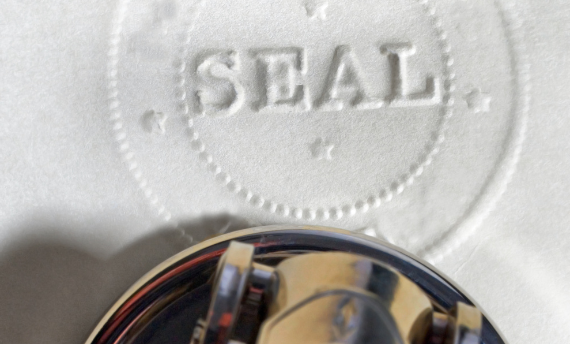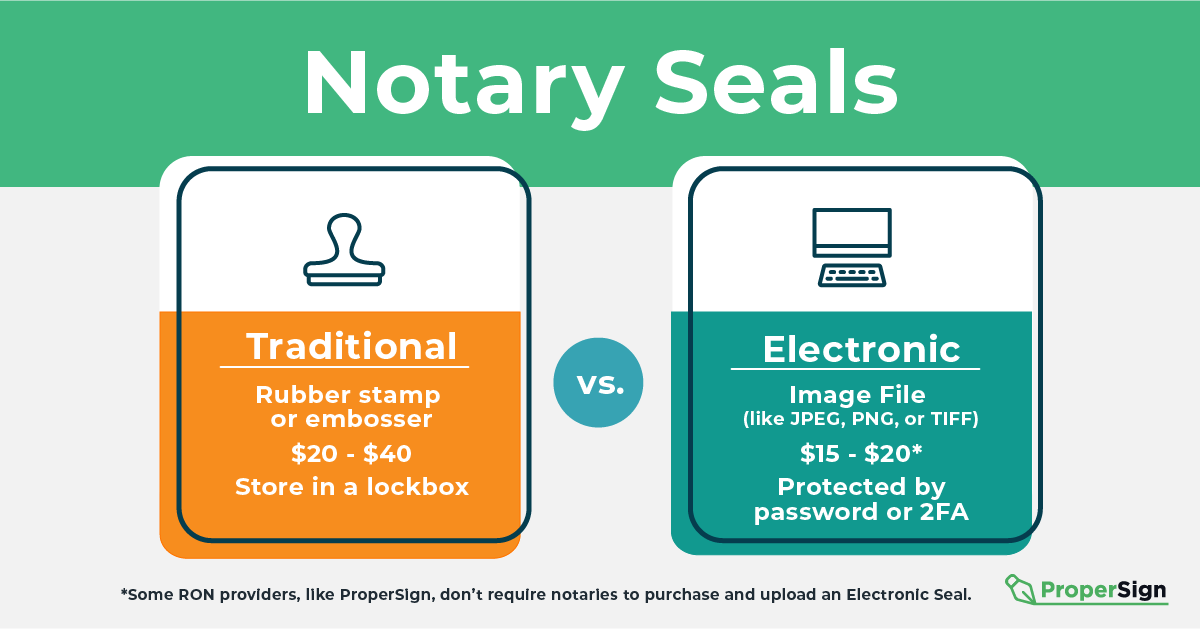
Amanda Farrell - 2 years ago

Applying a notary seal to a document is a quintessential part of the notarial ceremony, making the stamp a mandatory part of the notary toolbox. A notary seal or stamp can look a little different depending on the commissioning state, and each state has its own set of requirements to obtain a Notary seal.
With the introduction of remote online notarization, there’s some confusion around what an electronic notary seal is and how it works.
Here are some important distinctions between a traditional notary seal and an eSeal.
In a traditional notarial ceremony conducted face-to-face, there are lots of tangible items used daily. After receiving your commission, it’s tempting to go on a shopping spree, buying notary accessories like stamps, embossers, gold foil seals, and decorated journals. Some of these items are a necessity, while others are a splurge.
In most cases, a notary stamp is the basic must-have tool.
The type of tool and the shape of the impression it makes may vary by state, but the following information can usually be found on a notary seal:
Each state has specific information required or prohibited on the seal. California requires the State Seal to be present, while Arkansas state code A.C.A. § 21-14-107 bans the use of both the state seal and an outline of the state. Nevada’s code allows the notary to decide whether or not to add the Seal of the State of Nevada. Often, the county where a notary is commissioned and bonded will also appear. Before purchasing a notary stamp or other supplies, be sure to confirm that the product has all of the information required by the commissioning state.
In addition to the typical rectangular ink stamp, there are also seals and embossers. Sometimes seals and stamps may be used interchangeably. An embosser may also be called a seal in some places.
Notary Stamp: these tools are made of rubber and leave a flat impression from ink. They can be in the shape of a rectangle, but some states require a round stamp.
Notary Embosser: these tools clamp down on paper to produce a raised indentation of the Notary’s information. Typically, embossers are round and used in conjunction with a round ink rubber stamp. Once the most common tool for notaries, it has since been replaced by the rubber stamp in most states. However, some states still require the embosser as a measure against fraud since it’s not as easily reproduced as the stamp image. Notary Seals: Some customers may request a foil seal with an embossed impression because it provides an aesthetically pleasing and professional quality to the document. While the gold foil may be expected on papers received in other countries, this doesn’t necessarily increase the acceptability of the document at domestic recording offices.
Notary Seals: Some customers may request a foil seal with an embossed impression because it provides an aesthetically pleasing and professional quality to the document. While the gold foil may be expected on papers received in other countries, this doesn’t necessarily increase the acceptability of the document at domestic recording offices.
While notary publics commissioned by their state must always apply their seal as part of the notarial ceremony, some people aren’t required to use any seal or stamp.
Federal law and most states permit individuals serving with or working for the United States Armed Forces to perform notarial acts for military personnel and their families. There are far fewer restrictions for military notaries, which include commissioned officers, enlisted paralegals, judge advocates, or civilian lawyers licensed to practice law in the United States and working with the military. Only their signature and title are needed to validate the document.
With the growing use of remote online notarization and electronic notarization, notaries may wonder how traditional tools are used when there are no tangible documents.
The look of the seal doesn’t change much in states that have approved RON, but what has changed is how the seal is made, used, and stored.

An electronic seal is an image, usually in the same layout as a rubber stamp, formatted as a JPEG, PNG, PDF, or TIFF. Some states or remote online notarization platforms may require other file types.
Notaries can usually purchase an electronic seal with the same vendors that provide traditional tools, costing anywhere between $15 and $20. Check with your state and RON provider before buying an eSeal.
With ProperSign, there is no extra charge for the electronic seal.
Since the electronic seal is usually an image file, it must be used along with an identity-based digital certificate. The image is applied to the appropriate electronic documents to show it was notarized. Data pulled from the digital certificate is added within a tamper-proof seal or transparent layer. You can view this information in PDF editor programs like Adobe Acrobat.
According to IdenTrust, one of the largest providers of digital certificates, “Many federal, state, and local agencies now accept digital professional seals (such as engineer, architect, surveyor, and notary seals) in conjunction with digital signatures. In fact, some state Department of Transportation (DoT) agencies and cities now require the use of digital signing and sealing on plan submissions.”
Like a traditional seal, the notary must take steps to protect the electronic seal. If storing the eSeal on a personal computer or hard drive, notaries should consider password protecting these files or use encryption software. RON software providers may require notaries to enter passcodes, enable two-factor authentication, or other methods of verifying the user before accessing their account, entering a digital signing event, or applying the electronic seal.
While there are many similarities between a traditional and electronic notarization, it’s important to understand how technology is creating changes. Becoming RON certified is fairly easy in most states, but many notaries struggle with finding the right software and resources to implement RON successfully in their business.
Subscribe to our blog for more RON resources and updates or contact our sales team for a look at ProperSign.

This content is provided for informational purposes only. PropLogix, LLC (PLX) is not a law firm; this content is not intended as legal advice and may not be relied upon as such. PLX makes no representations as to the accuracy, reliability, or completeness of this content. PLX may reference or incorporate information from third-party sources, upon which a citation or a website URL shall be provided for such source. PLX does not endorse any third party or its products or services. Any comments referencing or responding to this content may be removed in the sole discretion of PLX.